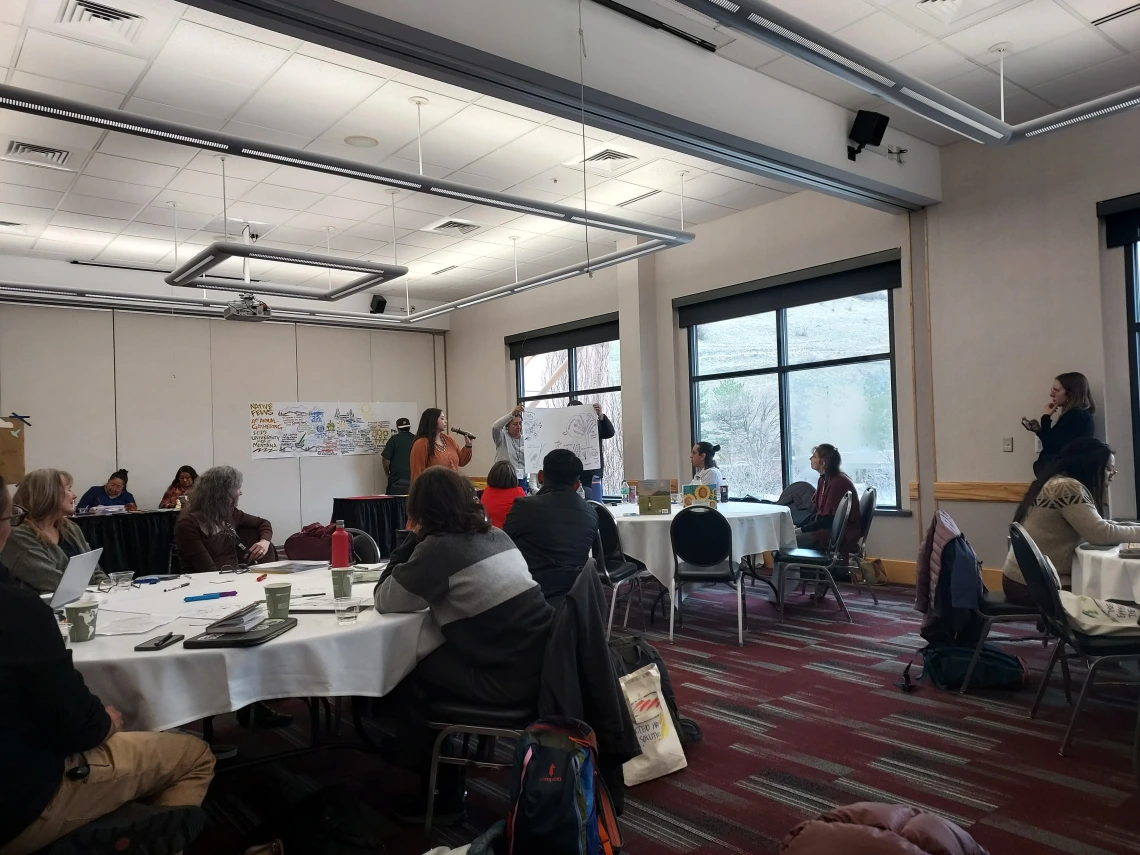Ambassador Presentation for Native FEWS Gathering 2025

The Native Food Energy, Water System (FEWS) Ambassador program began meeting monthly in August. FEWS Ambassador bylaws and goals were submitted and approved in December 2024. In January 2025, the ambassadors began meeting bi-weekly with their advisor, Lisa Vandever and voted on their first Native FEWS gathering presentation topic. There were three topics suggested: Traditional Ecological Knowledge (TEK) and picture books, Water and Invasive Species, Climate Change and Traditional Foods. The TEK and picture books topic was selected. The Ambassadors began working on their presentation in March.
Ph.D student Gayla Gould wanted to discuss the term TEK in depth. According to Gould, the term TEK is a western term for academia and the tribes in Idaho have decided to refer to their Indigenous ways of knowing using their tribal languages. Gould shared a short story about a beaver who worked alone and at night. The animals of the forest were critical of the beavers' work and they could not understand Beavers' process. Beavers are an important part of the ecosystem. Their dams help improve water quality, yet they are often regarded as a nuisance. TEK is older than the ideas of climate change, resource management, and environmental justice. “The term traditional ecological knowledge came into widespread use in the 1980s, but the practice of traditional ecological knowledge is as old as ancient hunter-gatherer cultures” (Berkes, 2018, p. 2). Traditional Ecological Knowledge (TEK) is knowledge that Indigenous people know and have regarding their ecosystems. This knowledge combines culture and spiritual beliefs with the environment and ecosystems that reside in the six cardinal directions.
Traditional Ecological Knowledge classes are often housed in American Indian Studies or Geology departments. They are often cross-listed with other departments and are not required courses but rather offered as electives or options to fill a need. TEK is not regarded as a science class, and it does not fulfill a science credit, so the ambassadors wanted to bring this information to the Annual FEWS gathering in Montana. Gould and LaCher Pacheco worked on a presentation that would include TEK and storytelling about flora and fauna.
Pacheco’s doctoral major is in Children’s and Young Adult Literature and she was able to share information about Louise Rosenblatt’s reader response theories (1928/1994). Rosenblatt, author of Literature as Exploration (1938) and The Reader, the Text, the Poem: The Transactional Theory of Literary Work (1994) discusses the reader and their relationship with the text and poem. Using this theory, Pacheco was able to adapt a Reader Response strategy to show participants they can incorporate TEK into their lessons.
Nieves Vazquez and Pacheco worked on book talk presentations. A book talk introduces books and their themes to participants. Vandever was able to order eight children’s picture books for the Gathering and we hoped to host book talks with participants before engaging in the reader response strategy called Neighborhood Maps.
Pacheco and Charles Wells had the opportunity to present eight children's books at the 4th Annual Native F.E.W.S. Alliance gathering held at the University of Montana’s campus in Missoula. The central theme of the Indigenous-authored children's books was Traditional Ecological Knowledge. While the books presented this knowledge in a linear fashion, the underlying teaching principles stemmed from holistic Indigenous practices passed down through tribal oral traditions. Pacheco led the presentation of these books, emphasizing the significance of presenting Traditional Ecological Knowledge linearly in children's literature by Indigenous authors, and highlighted the limited selection of published Indigenous authors on this subject. From Well’s perspective, Pacheco effectively captured the audience's attention and fostered engagement throughout our presentation.
In Montana, Wells suggested we skip the book talk so he could talk about the plants that grow in Montana and how important plants are to people. The change added a nonlinear perspective and also connected the presentation to the theme of the Gathering: Food is Energy. Wells spoke about bitterroot, sage and huckleberry. Then Pacheco presented the book, Sunflower House (1999) by Eve Bunting and illustrated by Kathryn Hewitt which is a picture book about a boy who plants a mammoth sunflower. The father suggests the boy plant the seeds in a circle instead of a row like the packet instructions read. The circle becomes a house for children. The boy plays in the house all summer long with his friends. And at the end of the summer they harvest the sunflower seeds.
The father in the story relies on his own relationship with sunflowers and his family's ways of knowing. The boy in the book sits in his sunflower house and wonders about the spaces outside of his house. He invites his friends to harvest the seeds and they leave a trail of flowers in their neighborhood.
After listening to the picture book, participants were asked to create a neighborhood map of plants that grew in their neighborhood. The participants drew a variety of plants, trees and even grass. Some drawings included traditional names of plants which were accompanied by short memories and stories. The group dialogued about the plants that were significant to their youth.
After sharing plant stories, we talked about the importance of Indigenous Ways of knowing and how we can bring Indigenous Ways of Knowing to the classroom. The goal of the presentation was met as tables of eight or more shared their plant stories and Traditional Ecological practices and resource management.
-30-
References:
Berkes, F. (2018). Sacred ecology (Fourth edition.).
Children’s Picture Book
Bunting, E. (1999). Sunflower House. Houghton Mifflin Harcourt.
